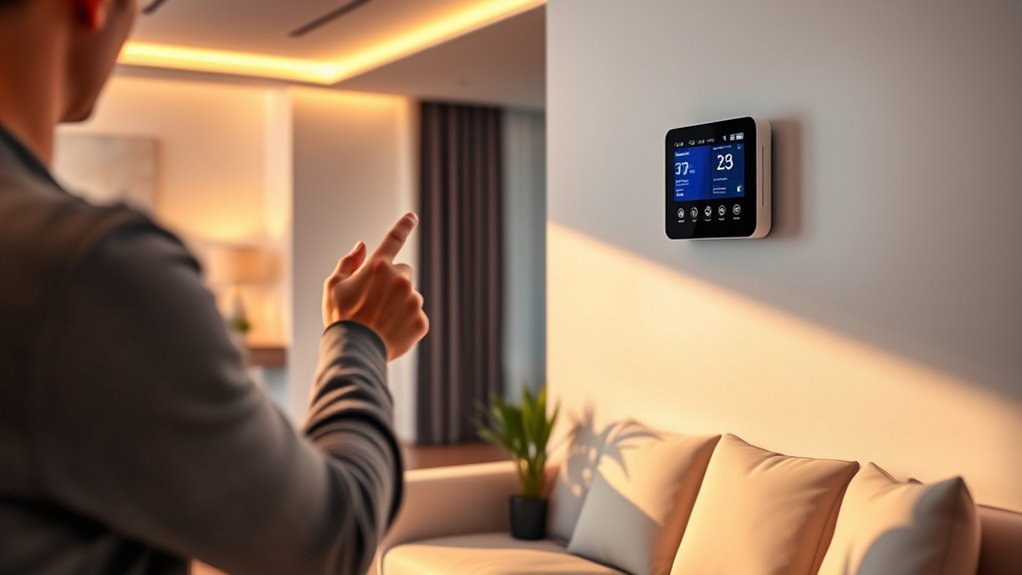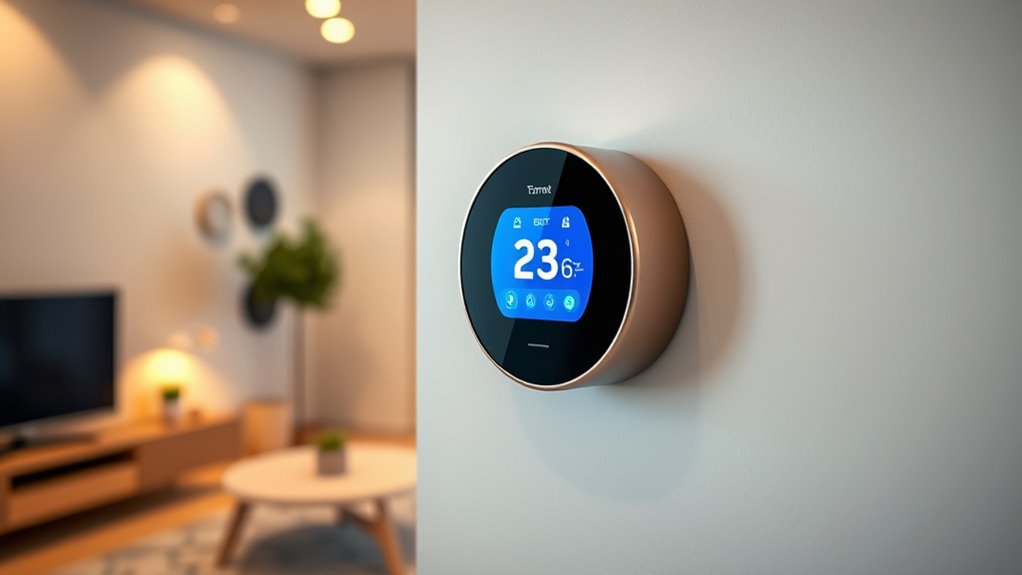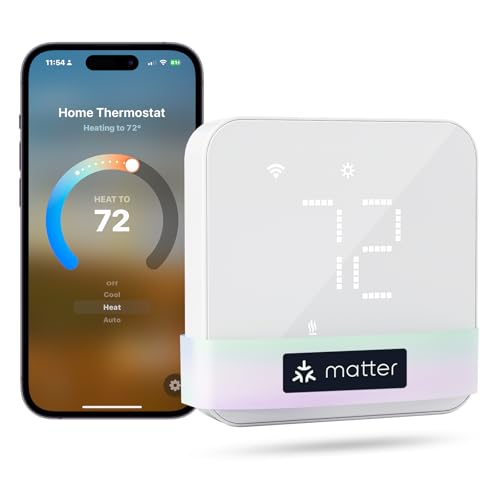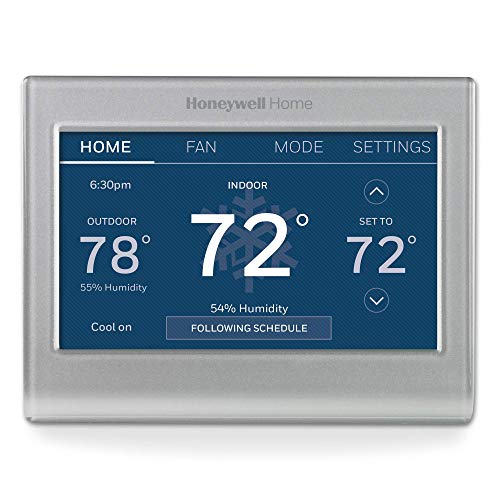If you’re looking to upgrade your home for better comfort and energy savings, I recommend exploring the 14 best smart thermostats for 2025. From models like ecobee with sensors to Nest’s learning features, there’s something to fit every budget and system. These devices help cut energy costs by up to 26% and integrate seamlessly with smart home setups. Keep exploring to discover which thermostat is perfect for your home and needs.
Key Takeaways
- Modern smart thermostats offer significant energy savings of up to 26%, reducing utility bills in 2025.
- They feature intuitive touchscreens, customizable interfaces, and seamless app controls for easy home management.
- Compatibility with popular smart home ecosystems like Apple HomeKit, Google Assistant, and Alexa enhances home automation.
- Advanced models include room sensors, weather forecasting, and adaptive algorithms for optimal comfort and efficiency.
- Easy DIY installation with minimal wiring requirements makes upgrading to smart thermostats accessible for most homeowners.
ecobee Smart Thermostat Essential – Wi-Fi Thermostat with Voice Assistant Compatibility
If you’re looking for an affordable, energy-efficient smart thermostat that’s easy to install and use, the ecobee Smart Thermostat Essential is a great choice. It can save you up to 23% annually on heating and cooling costs by automatically adjusting to your schedule, reducing energy use when you’re away, and maintaining comfort when you’re home. Its user-friendly color touchscreen makes temperature adjustments simple, and no C-wire is needed for DIY installation—just use the optional Power Extender Kit. Plus, it’s compatible with most HVAC systems and integrates seamlessly with Apple, Google, and Alexa voice assistants, making your home smarter and more efficient.
Best For: homeowners seeking an affordable, easy-to-install smart thermostat that enhances energy efficiency and integrates seamlessly with popular voice assistants.
Pros:
- Saves up to 23% annually on heating and cooling costs through smart scheduling and remote energy monitoring.
- Easy DIY installation with no C-wire needed, thanks to the optional Power Extender Kit.
- Compatible with most HVAC systems and leading smart home platforms like Apple HomeKit, Google Assistant, and Alexa.
Cons:
- May not be compatible with 100% of HVAC systems; users should verify compatibility via the ecobee Compatibility Checker.
- Lacks advanced features found in higher-end thermostats, such as advanced zoning or detailed energy analytics.
- Does not include the Power Extender Kit or trim kit; these must be purchased separately if needed.
Amazon Smart Thermostat
The Amazon Smart Thermostat stands out as an excellent choice for homeowners seeking a reliable, energy-efficient upgrade that integrates seamlessly with Alexa and Ring devices. Built with Honeywell Home Thermostat Technology, it’s backed by 130 years of industry experience. Certified ENERGY STAR, it helps save around $50 annually on energy bills, with potential rebate info provided by Amazon. It automatically adjusts heating and cooling based on temperature and presence detection, offering comfort zones via Echo devices or the Amazon Smart Air Quality Monitor. Control it remotely through the Alexa app, and enjoy easy installation with guided support. Dependable and smart, it’s a solid upgrade for any modern home.
Best For: homeowners seeking a reliable, energy-efficient smart thermostat that seamlessly integrates with Alexa and Ring devices for convenient remote control and automation.
Pros:
- Compatible with Alexa and Ring for easy voice control and automation
- ENERGY STAR certified, helping save approximately $50 annually on energy bills
- Built with trusted Honeywell Home Thermostat Technology for reliability and long-term performance
Cons:
- Requires a C-wire for installation, which may not be available in all homes
- Limited compatibility with non-Alexa or Ring smart home ecosystems
- May need assistance from customer support during setup for optimal configuration
ecobee Smart Thermostat Enhanced, Wi-Fi Programmable Thermostat
For homeowners seeking an energy-efficient thermostat that seamlessly integrates with their smart home systems, the ecobee Smart Thermostat Enhanced stands out as a top choice. It adjusts temperatures automatically based on occupancy, sleep, and away modes, helping save up to 26% annually on energy costs. Compatible with most 24 VAC HVAC systems and featuring a Power Extender Kit, installation is straightforward. The responsive LCD touch screen, app control, and compatibility with platforms like Alexa and Apple HomeKit make it easy to manage. Users appreciate its ability to optimize comfort and energy efficiency, making it a reliable, smart upgrade for any home.
Best For: homeowners seeking an easy-to-install, energy-efficient smart thermostat that integrates seamlessly with popular smart home platforms.
Pros:
- Offers automatic energy savings of up to 26% annually through occupancy and schedule-based adjustments
- Compatible with most 24 VAC HVAC systems and includes a Power Extender Kit for easy installation without a C-wire
- Provides remote control and monitoring via app and voice assistants like Alexa and Apple HomeKit
Cons:
- Installation may require professional help, especially for homes without a C-wire
- Some users report the display turns off when approaching, with no persistent standby screen
- Website login and bookmark features are limited, which may affect user convenience
Sensi Smart Thermostat
Among the top smart thermostats, the Sensi Smart Thermostat stands out for homeowners seeking a reliable, easy-to-install device that offers advanced compatibility and energy savings. I found it straightforward to set up, thanks to its built-in level and detailed app instructions. Compatible with most HVAC systems, including multi-zone setups, it works with Alexa, Google Assistant, and other platforms. Its Energy Star certification guarantees efficient operation, reducing energy bills by around 23%. With remote control, scheduling, and maintenance alerts, I can manage my home’s climate from anywhere. Plus, its sleek design and privacy focus make it a practical, smart choice for modern households.
Best For: homeowners seeking an easy-to-install, reliable smart thermostat with broad compatibility and energy-saving features.
Pros:
- User-friendly installation with built-in level and detailed app guidance
- Compatible with multiple smart home platforms including Alexa and Google Assistant
- Energy Star certified, helping reduce energy bills by approximately 23%
Cons:
- Some delays in system response, such as a 20-25 second delay between adjustments and system activation
- Occasional inaccuracies in system status readings due to external factors like clogged drain lines
- Limited compatibility with certain smart home platforms like Bixby
ecobee Smart Thermostat Premium with Sensors
If you’re looking to optimize comfort and energy savings in specific rooms, the ecobee Smart Thermostat Premium with Sensors is an excellent choice. It can save you up to 26% annually on heating and cooling costs and includes a SmartSensor valued at $50 to eliminate hot and cold spots. The thermostat automatically pauses HVAC activity if a window or door stays open for 5 minutes, reducing waste. It also offers features like weather forecasting, TOU rate plan support, and solar power compatibility. Easy to install and sleek in design, it integrates seamlessly with smart home systems and voice assistants, making home comfort smarter and more efficient.
Best For: homeowners seeking to optimize energy efficiency and comfort in specific rooms with smart, integrated climate control solutions.
Pros:
- Helps save up to 26% annually on heating and cooling costs, reducing energy bills.
- Includes SmartSensor to eliminate hot and cold spots, enhancing comfort.
- Seamless integration with popular smart home systems and voice assistants for easy control.
Cons:
- Some users report sensor accuracy issues or regional limitations affecting functionality.
- Requires compatible HVAC systems and may need additional accessories like the Power Extender Kit for certain setups.
- Higher upfront cost compared to basic thermostats, which may be a consideration for budget-conscious users.
meross Smart Thermostat for Home with WiFi and Matter Compatibility
The meross Smart Thermostat stands out as an excellent choice for homeowners seeking reliable, easy-to-install control over their HVAC systems, especially those with modern smart home setups. It works with 95% of HVAC systems, including heat pumps and cooling-only units, but not electric baseboard heaters. You’ll need a C-wire or a meross adapter for installation. With Wi-Fi and Matter compatibility, it integrates seamlessly with platforms like Alexa, Google Assistant, Apple HomeKit, and Samsung SmartThings. Its simple app setup, 7x24h scheduling, and optional room sensors make managing home comfort effortless, all while helping reduce energy costs.
Best For: homeowners seeking a reliable, easy-to-install smart thermostat compatible with most HVAC systems and modern smart home platforms.
Pros:
- Seamless integration with Alexa, Google Assistant, Apple HomeKit, Samsung SmartThings, and Matter technology.
- Easy setup via the Meross app with intuitive controls and 7x24h scheduling.
- Energy monitoring features that help reduce utility bills and optimize home comfort.
Cons:
- Not compatible with electric baseboard heaters.
- Requires a C-wire or meross C-wire adapter for installation, which may be challenging for some users.
- Some users report minor wiring difficulties during installation.
Sensi Lite Smart Thermostat
The Sensi Lite Smart Thermostat stands out for its easy DIY installation and user-friendly features, making it an ideal choice for homeowners seeking a quick, hassle-free upgrade to their HVAC system. It offers Wi-Fi connectivity, programmable scheduling, and compatibility with Alexa, all without needing a C-wire in most cases. Certified by ENERGY STAR, it helps you save around 23% on energy costs through flexible scheduling, geofencing, and remote control via a mobile app. Designed for straightforward installation with clear instructions and a built-in level, the Sensi Lite emphasizes privacy and security, giving you peace of mind while managing your home’s comfort from anywhere.
Best For: homeowners seeking an easy-to-install, energy-efficient smart thermostat with remote control and privacy assurance.
Pros:
- Easy DIY installation with built-in level and clear instructions
- Compatible with most HVAC systems and Alexa, no C-wire needed in most cases
- Helps save approximately 23% on energy costs through flexible scheduling and geofencing
Cons:
- Not compatible with all heat/cool and heat pump systems requiring a C-wire
- Limited advanced customization options compared to more complex thermostats
- Requires a stable Wi-Fi connection for optimal remote functionality
RTH9585WF1004 Wi-Fi Smart Color Thermostat
Looking for a smart thermostat that combines customization, ease of use, and energy savings? The RTH9585WF1004 Wi-Fi Smart Color Thermostat might be just what you need. It features customizable colors to match your décor and a bright, easy-to-read touchscreen for simple operation. Compatible with various heating systems, it supports Wi-Fi for remote control and voice commands via Alexa. As Energy Star certified, it helps reduce energy consumption by tracking usage patterns and offering personalized tips. Plus, you can explore rebate programs and utility incentives, making it a smart choice for saving money and supporting sustainability in 2025.
Best For: homeowners seeking a customizable, energy-efficient smart thermostat that integrates seamlessly with their smart home setup and helps reduce utility costs.
Pros:
- Customizable color options to match home décor
- Supports Wi-Fi and voice control via Alexa for remote operation and convenience
- Energy Star certified with usage tracking and personalized energy-saving tips
Cons:
- Requires a C-wire for installation, which may not be available in all homes
- Does not support electric baseboard heating systems (120-240V)
- Compatibility limited to forced air, hot water, steam, and heat pump systems with electric backup
Sensi Touch 2 Smart Thermostat with Touchscreen Display
If you want a smart thermostat that combines sleek design with easy control, the Sensi Touch 2 stands out thanks to its vibrant touchscreen display. I love how intuitive it is to set up and adjust, with its colorful interface making navigation a breeze. It’s compatible with most HVAC systems requiring a C-wire and supports room sensors (sold separately) to balance temps. With Wi-Fi connectivity, I can easily control it remotely or use Alexa voice commands. Plus, it helps save around 23% on energy costs through flexible scheduling and detailed reports. Its focus on privacy and straightforward installation make it a smart addition to any home.
Best For: homeowners seeking an easy-to-use, energy-efficient smart thermostat with a sleek touchscreen interface and remote control capabilities.
Pros:
- Vibrant, intuitive touchscreen display for simple navigation and control
- Supports room sensors (sold separately) to balance temperatures across different areas
- Compatible with most HVAC systems requiring a C-wire and integrates with Alexa voice control
Cons:
- Requires a C-wire for installation; not suitable for systems without one
- Room sensors are sold separately, adding to the overall cost
- DIY installation may be challenging for some users despite app guidance
Vine Smart Thermostat with Touchscreen Display
For those seeking a sleek and user-friendly smart thermostat, the Vine Smart Thermostat with Touchscreen Display stands out thanks to its intuitive 2.8-inch LCD screen and modern square design. It supports digital, app, and voice control (Alexa, Google Assistant), making it easy to adjust settings from anywhere. Compatible with 90% of HVAC systems, including heat pumps, electric, gas, and oil, it offers programmable schedules, auto modes, and geofencing. Setup is quick—typically under 20 minutes—and the app allows remote control and firmware updates. Despite some initial calibration issues, recent firmware updates have improved performance, making it a reliable, energy-saving choice.
Best For: homeowners and DIY enthusiasts seeking a stylish, easy-to-install smart thermostat compatible with a wide range of HVAC systems and featuring app and voice control.
Pros:
- Modern square design with a clear 2.8-inch LCD touchscreen for intuitive use
- Supports multiple control options including digital, app, and voice commands (Alexa, Google Assistant)
- Compatible with 90% of HVAC systems and offers programmable schedules, auto modes, and energy-saving features
Cons:
- Initial calibration issues reported by some users, though recent firmware updates have addressed these concerns
- Requires a C-wire for proper operation, which may necessitate additional wiring in some setups
- Occasional connectivity problems that can often be resolved with firmware updates or re-setup
Google Nest Learning Thermostat (4th Gen, 2024)
The Google Nest Learning Thermostat (4th Gen, 2024) stands out as the most intelligent and advanced option in the lineup, thanks to its 60% larger display with Dynamic Farsight that lets you see important information from across the room. It automatically adjusts brightness for easy viewing and offers customizable display options like a clock or weather. The thermostat manages heating and cooling intelligently, requesting permission for schedule changes to save energy. Compatible with most 24V systems and easy to install without a C wire, it seamlessly integrates with Alexa, Siri, and Google Assistant, and can be controlled remotely via the Google Home app for ultimate convenience.
Best For: Homeowners seeking an intelligent, easy-to-install smart thermostat with advanced features and seamless smart home integration.
Pros:
- Large 60% bigger display with Dynamic Farsight for easy visibility from across the room
- No C wire required for most installations, simplifying setup
- Compatible with Alexa, Siri, Google Assistant, and Matter for versatile voice and smart home control
Cons:
- Higher price point compared to basic thermostats
- May require app or voice control for full functionality, which could be complex for some users
- Limited compatibility with certain non-24V heating systems
RTH8800WF2022 T5 WiFi Smart Thermostat
The Honeywell RTH8800WF2022 T5 WiFi Smart Thermostat stands out as an excellent choice for homeowners seeking a versatile and easy-to-use device with robust smart features. I appreciate its 7-day programmable schedule and compatibility with Alexa, Google Assistant, and Apple HomeKit, making voice control effortless. Its auto changeover, auto-away, and geofencing ensure e*ssential* comfort and energy savings. The sleek black finish and LCD display add style, while energy reports help me track usage and save on bills. Although some connectivity quirks exist, its user-friendly interface and energy-efficient design make it a reliable, smart upgrade for modern homes.
Best For: homeowners seeking an easy-to-use, smart WiFi thermostat with compatibility across major voice assistants and energy-saving features.
Pros:
- Compatible with Alexa, Google Assistant, and Apple HomeKit for seamless voice control
- Programmable 7-day schedule and geofencing enhance comfort and energy efficiency
- Sleek design with LCD touchscreen display adds aesthetic appeal to any home
Cons:
- Connectivity issues or resets may occur, affecting smart features’ reliability
- Some users experience challenges with scheduling algorithms overriding manual settings
- Requires a C-wire for installation in certain systems, which may necessitate additional wiring or adapters
Google Nest Learning Thermostat, 3rd Gen
If you’re looking to optimize your home’s energy use effortlessly, the Google Nest Learning Thermostat 3rd Gen stands out as an ideal choice. It learns your preferences and creates a personalized schedule, so you don’t have to program it manually. With remote control via the Nest app, you can adjust settings from anywhere. It supports voice commands through Alexa and Google Assistant. Its sleek design features a bright digital display and stainless steel finish. Plus, Home/Away Assist detects occupancy to save energy, and the Nest Leaf indicates energy-efficient choices. Many users see noticeable savings and appreciate its user-friendly setup, making it a smart, efficient upgrade for any home.
Best For: homeowners seeking a user-friendly, energy-efficient smart thermostat that learns preferences and offers remote control and voice command compatibility.
Pros:
- Learns user habits to create automatic, personalized schedules reducing manual adjustments
- Supports remote control via the Nest app and voice commands through Alexa and Google Assistant
- Sleek, modern design with a bright digital display and energy-saving features like Home/Away Assist and Nest Leaf indicator
Cons:
- Installation may require careful wiring verification and safety precautions during setup
- Energy savings depend on individual usage and home conditions, not guaranteed
- Compatibility with older HVAC systems may vary; users should verify with Google’s compatibility checker
RTH9600WF Smart Color Thermostat
For homeowners seeking a versatile, energy-efficient smart thermostat, the RTH9600WF Smart Color Thermostat stands out thanks to its customizable high-definition color display and compatibility with popular smart home platforms like Alexa. I appreciate its ability to change colors to match your decor or mood, plus its on-screen display shows indoor and outdoor temperatures, humidity, and weather forecasts. It works with various systems, including gas, oil, electric, and heat pumps, though not electric baseboard heat. With ENERGY STAR certification, it helps reduce energy use, offers remote control via app, and supports personalized scheduling for maximum savings and convenience.
Best For: homeowners seeking a customizable, energy-efficient smart thermostat compatible with various heating systems and smart home platforms.
Pros:
- Customizable high-definition color display that can match decor or mood
- Compatibility with popular smart home platforms like Alexa, Google Assistant, and Cortana
- ENERGY STAR certified, helping reduce energy consumption and costs
Cons:
- Requires a C-wire for proper operation; may need a power adapter if not available
- Not compatible with electric baseboard heating (120-240V) systems
- Installation may require basic electrical knowledge or professional assistance
Factors to Consider When Choosing Smart Thermostats

When choosing a smart thermostat, I consider how well it works with my HVAC system and how easy it is to install. I also look for energy-saving features and how it connects with my existing smart home devices. Finally, I evaluate the control options available to find the most convenient way to manage my comfort.
Compatibility With HVAC Systems
Choosing a smart thermostat requires making sure it’s compatible with your HVAC system’s specific characteristics. First, check if it supports your system’s voltage, whether 24V or high-voltage, since most support standard 24V systems but not electric baseboards or high-voltage setups. Confirm if your system is a gas, electric, heat pump, or boiler, as some thermostats are designed for specific types. Many models need a C-wire for continuous power; if you lack one, verify compatibility or consider alternatives. For multi-zone or multi-stage systems, make certain the thermostat can handle multiple zones or stages for ideal control. Using manufacturer tools or compatibility checkers can help verify your system and wiring meet the thermostat’s requirements, preventing future issues and ensuring seamless operation.
Installation Complexity Levels
Installation complexity can vary considerably depending on the smart thermostat model you select. Some models are designed for easy DIY setup, featuring clear on-screen guides and app-based instructions that make installation straightforward even for beginners. Many don’t require a C-wire, instead including power extender kits or alternative wiring options to simplify the process. However, models supporting multi-zone systems or advanced HVAC configurations often need specialized wiring or calibration, which may require professional help. Overall, the ease of installation hinges on clear instructions, wiring compatibility, and whether support options are available. If you’re comfortable with basic wiring, choosing a thermostat with simple setup features can save time and hassle. For complex systems, professional installation might be the better route to guarantee proper operation.
Energy Saving Features
Smart thermostats are designed to help you save energy by automatically adjusting your home’s temperature based on occupancy, time of day, and your preferences. They use features like programmable schedules, geofencing, and adaptive algorithms to reduce HVAC energy consumption by 23% or more annually. Sensor-based zone control and humidity management optimize comfort while avoiding unnecessary heating or cooling. Look for models with ENERGY STAR certification, which ensures high energy efficiency and lower utility bills over time. Remote access and real-time monitoring give you the ability to make energy-conscious adjustments from anywhere, enhancing savings. These features work together to create a more efficient home, helping you cut costs without sacrificing comfort. Choosing a thermostat with strong energy-saving capabilities can substantially impact your energy bills in the long run.
Smart Home Integration
Integrating a smart thermostat with your existing home system can considerably enhance convenience and functionality. Compatibility with platforms like Apple HomeKit, Google Assistant, and Amazon Alexa makes voice control and automation straightforward. Support for protocols such as Matter, Zigbee, or Z-Wave broadens integration with various smart devices, ensuring your thermostat works seamlessly within your ecosystem. Easy setup through dedicated apps allows quick linking to other smart home components, saving time and effort. Additionally, thermostats that support automation routines can trigger lights, security systems, or blinds based on temperature or occupancy sensors, creating a more responsive environment. Compatibility with existing smart hubs or controllers simplifies management and keeps everything centralized, making your smart home truly cohesive and easier to control.
Control Methods Available
Choosing the right control method for your smart thermostat is crucial because it directly affects how easily and quickly you can adjust your home’s temperature. Some models feature physical interfaces like touchscreens or buttons, which offer direct, tactile control. Others support remote operation through smartphone apps, giving you the flexibility to adjust settings from anywhere. Voice control is also common, compatible with virtual assistants like Alexa, Google Assistant, or Siri, enabling hands-free adjustments. Additionally, many thermostats support programmable schedules and geofencing, automating temperature changes based on your location or time of day. The control method impacts ease of use, responsiveness, and how well the thermostat integrates with your other smart home devices. Choosing the right method ensures your comfort is always just a command or tap away.
User Interface Design
When selecting a smart thermostat, paying attention to the user interface design can make a significant difference in your overall experience. A user-friendly interface with a clear, responsive touchscreen or display simplifies adjusting temperatures and managing schedules. Intuitive navigation, with labeled icons and minimal menus, reduces the learning curve and makes operation straightforward. Visual elements like color schemes, icons, and real-time data help you quickly understand and respond to your home’s climate needs. Customizable options, such as display brightness and layout, enhance visibility and cater to personal preferences. Additionally, seamless integration of control methods—touch, app, and voice—ensures versatile, accessible interaction, making your smart thermostat both easy and enjoyable to use every day.
Cost and Rebate Options
Considering the varying costs of smart thermostats, it’s important to explore available rebate and incentive options to make your investment more affordable. Many models are ENERGY STAR certified, which can qualify you for rebates from local energy providers. Basic models start around $50, while advanced ones can exceed $250, affecting rebate eligibility. Some utility companies offer direct rebates or discounts for purchasing and installing qualifying thermostats, helping to lower upfront costs. Be sure to check the specific eligibility criteria and gather proof of purchase and installation to maximize savings. Taking advantage of these programs can considerably shorten your payback period and improve energy savings, making a smart thermostat a more economical choice in the long run.
Privacy and Data Security
As smart thermostats become more popular, safeguarding your privacy and data security is essential. Many devices collect data like temperature adjustments, occupancy patterns, and usage habits, which can pose privacy risks if not properly protected. Reputable brands typically use encryption protocols such as SSL/TLS to secure data during transmission, reducing interception risks. Some manufacturers explicitly state they don’t sell or share personal information, demonstrating strong privacy policies to build trust. It’s important to review privacy settings in the thermostat’s app, controlling what data is shared and enabling opt-out options if available. Additionally, regular firmware updates often include security patches that defend against vulnerabilities, ensuring your data remains protected over time. Prioritizing these factors helps keep your home both comfortable and secure.
Frequently Asked Questions
How Do Smart Thermostats Impact Long-Term Energy Savings?
Smart thermostats substantially boost long-term energy savings by optimizing your home’s heating and cooling schedules based on your habits. I’ve seen how they learn my preferences, reduce unnecessary energy use, and adjust settings automatically. This means I spend less on energy bills over time. Plus, I appreciate the convenience of remote control and detailed usage data, helping me make smarter decisions and save money while staying comfortable.
Are Smart Thermostats Compatible With All HVAC Systems?
Imagine a puzzle piece fitting perfectly into its spot—that’s how compatible smart thermostats are with HVAC systems. Most modern systems work seamlessly, but older models might need adapters or upgrades. I recommend checking your HVAC’s specifications or consulting a professional. Rest assured, I’ve found many smart thermostats designed for broad compatibility, ensuring you enjoy smarter, more efficient home climate control without hassle.
What Is the Typical Installation Process for Smart Thermostats?
The typical installation process for smart thermostats is straightforward. I start by turning off the power to my HVAC system, then remove the old thermostat. I connect the new smart thermostat wires to the corresponding terminals, following the manufacturer’s instructions. After securing it on the wall, I turn the power back on and follow the setup prompts on the device or app. It usually takes about 30 minutes, and I’m good to go!
Can Smart Thermostats Be Controlled Remotely Without Internet?
Did you know that over 80% of smart thermostat owners control their devices remotely? Yes, many smart thermostats can be operated without internet, but only if they have local control features like built-in screens or compatible apps that connect via Bluetooth or Zigbee. I’ve found that while remote access usually needs Wi-Fi, some models offer manual control options, so you’re not completely cut off if the internet drops.
How Secure Is Data Privacy With Smart Thermostat Apps?
I believe data privacy with smart thermostat apps can be quite secure if you choose reputable brands that prioritize encryption and regular security updates. I always make sure to use strong, unique passwords and enable two-factor authentication when available. While no system is completely foolproof, taking these precautions markedly reduces the risk of unauthorized access, giving me peace of mind knowing my home data stays protected.
Conclusion
Did you know that smart thermostats can cut your energy bills by up to 12%? With so many great options like ecobee and Nest, there’s a perfect fit for every home. Investing in the right thermostat not only boosts comfort but also saves you money in the long run. Don’t wait—upgrade your home’s climate control today and enjoy smarter, more efficient living in 2025!
Meet Asra, a talented and adventurous writer who infuses her passion for exploration into every word she writes. Asra’s love for storytelling and her insatiable curiosity about the world make her an invaluable asset to the Voyager Info team.
From a young age, Asra was drawn to the power of words and their ability to transport readers to far-off lands and magical realms. Her fascination with travel and cultures from around the globe fueled her desire to become a travel writer, and she set out on a journey to turn her dreams into reality.


























